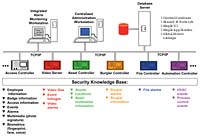Finding Seamless Integration of Digital Video

It's time for security to view digital video more as an integrated contributor to an organization's total enterprise protection needs. Digital video has undergone a significant transformation. Digital video technology has become popular as a replacement for analog CCTV. As a result, digital video recorders and stand-alone systems have become a large and fast growing segment. Of course, many businesses have spent a great deal of capital on existing analog systems and associated infrastructure. At the same time, they understand the value and need for digital video technology; and many companies have created budgets for digital video solutions. The technology is still new, and digital video recorder (DVR) devices are introduced almost every day. As a result, the focus has been on the "box." But end user interest should instead be directed toward what digital video technology can contribute to a business' total security environment.
There are three market segments in which digital video technology functions as part of a business solution. These include DVRs, non-integrated digital video management systems (DVMSs) and DVMSs as a seamlessly integrated part of a total security solution.
The most rudimentary of these is a stand-alone DVR. These devices are typically low cost replacements for analog video cassette recorders. Because of high demand and a proliferation of such hardware, DVRs have become price-based commodity items. They have limited functionality and operate independently of other systems, making them less effective in serving the more complex security needs of today's businesses.
Although a non-integrated DVMS offers substantial improvements over a simple DVR device, it is still limited.
It typically has a client workstation with a user interface to control recording and playback, limited search capabilities and video display in multiple windows similar to a security video matrix view. However, it is only a partial solution because it can't link video in the database to related alarms and event information from other systems (such as access control, intrusion detection, etc.) that are critical to a company's security needs. The system doesn't recognize that the different events are related, so they can't be monitored as a single occurrence in a central station monitoring environment.
Centralized administration and management of non-integrated systems is problematic and ineffective. Information is stored in files or, at best, in multiple databases. Such systems are difficult to manage and are cost inefficient, because management requires multiple security administrators. The fundamental problem remains that there are multiple unrelated systems trying to behave as one.
Digital video technology's true value to security is realized when it is seamlessly integrated into what I call a total security knowledge management solution. With seamless integration there is a single system based on a scalable distributed architecture, in which various components can be seamlessly plugged through well defined "open interfaces," and behave as an integral part of this system.
The heart of a seamlessly integrated solution is open architecture.
An open system is one that is designed in accordance with accepted standards of the computer industry, and one that can easily integrate with other applications and devices. Only a system that is both device and data exchange independent can be considered truly open. Open architecture allows a company to create a security management environment that includes non-proprietary, off-the-shelf devices and applications, standard operating systems and databases within the existing corporate network infrastructure. For digital video solutions, open architecture provides support for multiple video compression algorithms, video recorders and off-the-shelf, network-based storage devices. In such an environment, when technology migrates, the end user is not tied to a particular manufacturer.
In a seamlessly integrated system, video links to alarms or events generated by any third party field devices in the enterprise, including intrusion detection, fire, HVAC, access, asset and any other controllers. A seamlessly integrated system offers centralized management, administration, monitoring and reporting. Its single, centralized database contains all the information that, in a non-integrated environment, would be distributed among multiple databases. The open architecture design enables a system operator to view alarms and related video simultaneously on the same screen and in real time. These features provide a complete picture of what happens, where, to whom and when within the enterprise.
Take one example: theft of an employee credential or ID badge. When the credential is reported stolen, the system's centralized database is updated to reflect the new credential status. A subsequent attempt to access the facility using the stolen credential generates an alarm, which denies the thief access and initiates capture of digital video of the access attempt. A security officer located in another building or on the other side of the world views both the alarm information and the live video footage simultaneously on the same screen, and can respond better immediately. The video clip can be stored and archived for later retrieval.
In another example, an employee carries a notebook computer from Area A to Area B within a building. As the person moves through the doorway, portal readers register the employee's credential information, as well as the notebook's radio frequency asset tag number. The system checks the integrated database to verify whether that employee has permission to enter Area B at the time, and whether the employee has authority to move that notebook from Area A to Area B. If the person has such authority, access is granted to Area B. Otherwise, the system generates an alarm, access is denied and video footage captures of the person attempting to remove the notebook. The video clip can also export and forward via electronic mail to management and other security personnel.
These two very simple examples illustrate that digital video technology can be an invaluable tool for prevention and investigation, when seamlessly integrated into a total security solution. It offers flexibility, cost effectiveness, centralized administration and monitoring and instantaneous retrieval of vital information.
Looking for a reprint of this article?
From high-res PDFs to custom plaques, order your copy today!







